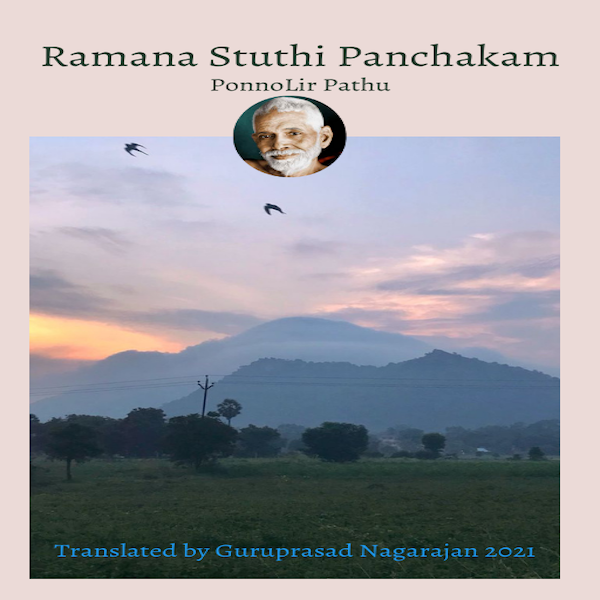Aadhi kaaraNa kaariyangal
Arindha sinmaya pooraNan;
Vaadhi ya mala maayai thannai
Vadhaithu veesidu maraNan.
Word meaning
aadhi = beginning; kaarana(m) = cause; kaariyam = work; sinmaya (chinmaya) = knowledeg of consciousness; pooraNan = one who is whole; mala(m) = impurities; maayai = illusion; vadhaithidu = to destroy; veesu = to throw out/away;
Meaning
Sri Ramana, the all-knowing Sadguru knows the First Cause and the consequent ‘work’. He is the whole one (pooraNan). He destroys (and throws away) the misery-causing illusion. He is the lord of death for the illusory world.
Bhagavan always maintained that the wrong identification with the body is the root cause of all problems and pains. All our questions, doubts and problems arise after the ‘I’ rises. “Thaan ezhundhal vaiyagam ezhum, thaan adanginal vaiyagam adangum” he used to say, meaning when ‘I’ rises, the world arises, and ‘I’ subsides, the world subsides’.
To a question on why there should be suffering, Bhagavan said:
You say the mind and body suffer. But do they ask the questions? Who is
the questioner? Is it not the one that is beyond both mind and body?
You say the body suffers in this life; the cause of this is the previous
life: its cause is the one before it, and so on. So, like the case of the
seed and the sprout, there is no end to the causal series.
It has to be said that all the lives have their first cause in ignorance. That
same ignorance is present even now, framing this question. That ignorance
must be removed by jnanam.
“Why and to whom did this suffering come?” If you question
thus you will find that the ‘I’ is separate from the mind and body, that
the Self is the only eternal being, and that It is eternal bliss. That is
jnanam.
By turning the questioner’s attention inwards, Sri Bhagavan guides us to find the Self that is beyond body-mind phenomena and thus destroys the attendant impurities.In Aksharamana malai verse 44, Bhagavan says:
Thirumbi agamthanai dhinam agak kaNN kaaNN
Theriyum endranti en Arunachala
Meaning
Arunachala! When I prayed to you to show me your real form, you graced me with the instruction to turn inwards and look inside with determination (vairagya) constantly, how strange is that? Because when ‘I’ remains as One, what can it know outside of it? What is the secret of your upadesa (instruction)?
Explanation
Ego stands in the way of self realisation (atma saatshatkaram). Self enquiry is the only way yo destroy the ego and achieve one’s real state/form. A sadhaka (spiritual practioner) has to constantly, every day, do self enquiry till the darkness of ignorance created by the ego is wiped out and the Self shines. This is what he means by ‘dhinam agak Kann kaNN, literally, daily inwards eye see = look inward every single day).
Arindha sinmaya pooraNan;
Vaadhi ya mala maayai thannai
Vadhaithu veesidu maraNan.
Word meaning
aadhi = beginning; kaarana(m) = cause; kaariyam = work; sinmaya (chinmaya) = knowledeg of consciousness; pooraNan = one who is whole; mala(m) = impurities; maayai = illusion; vadhaithidu = to destroy; veesu = to throw out/away;
Meaning
Sri Ramana, the all-knowing Sadguru knows the First Cause and the consequent ‘work’. He is the whole one (pooraNan). He destroys (and throws away) the misery-causing illusion. He is the lord of death for the illusory world.
Bhagavan always maintained that the wrong identification with the body is the root cause of all problems and pains. All our questions, doubts and problems arise after the ‘I’ rises. “Thaan ezhundhal vaiyagam ezhum, thaan adanginal vaiyagam adangum” he used to say, meaning when ‘I’ rises, the world arises, and ‘I’ subsides, the world subsides’.
To a question on why there should be suffering, Bhagavan said:
You say the mind and body suffer. But do they ask the questions? Who is
the questioner? Is it not the one that is beyond both mind and body?
You say the body suffers in this life; the cause of this is the previous
life: its cause is the one before it, and so on. So, like the case of the
seed and the sprout, there is no end to the causal series.
It has to be said that all the lives have their first cause in ignorance. That
same ignorance is present even now, framing this question. That ignorance
must be removed by jnanam.
“Why and to whom did this suffering come?” If you question
thus you will find that the ‘I’ is separate from the mind and body, that
the Self is the only eternal being, and that It is eternal bliss. That is
jnanam.
By turning the questioner’s attention inwards, Sri Bhagavan guides us to find the Self that is beyond body-mind phenomena and thus destroys the attendant impurities.In Aksharamana malai verse 44, Bhagavan says:
Thirumbi agamthanai dhinam agak kaNN kaaNN
Theriyum endranti en Arunachala
Meaning
Arunachala! When I prayed to you to show me your real form, you graced me with the instruction to turn inwards and look inside with determination (vairagya) constantly, how strange is that? Because when ‘I’ remains as One, what can it know outside of it? What is the secret of your upadesa (instruction)?
Explanation
Ego stands in the way of self realisation (atma saatshatkaram). Self enquiry is the only way yo destroy the ego and achieve one’s real state/form. A sadhaka (spiritual practioner) has to constantly, every day, do self enquiry till the darkness of ignorance created by the ego is wiped out and the Self shines. This is what he means by ‘dhinam agak Kann kaNN, literally, daily inwards eye see = look inward every single day).







 RSS Feed
RSS Feed